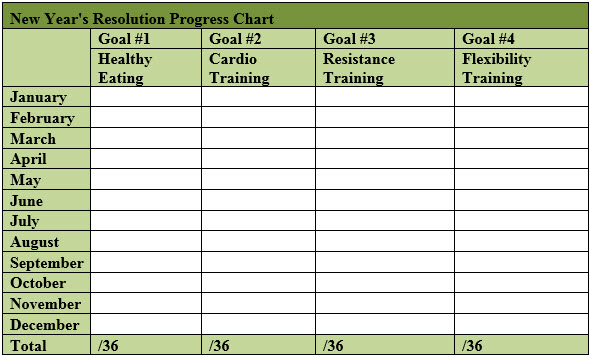How many of you are planning to set New Year’s Resolutions this year?
|

At a time when “social media” plays such a prominent role in communication, an anonymous quote came through one of our feeds that reminded us of this month’s topic of Goal-Setting and New Year’s Resolutions. The quote read:
“My goal for 2015 is to accomplish the goals of 2014 that I should have done in 2013 because I made a promise in 2012 and planned in 2011!”
Although funny, how many of us set goals that seem to get carried over year after year without paying too much attention to them due to lack of interest, level of difficulty, and other obstacles? For some reason or another, some goals are more difficult to achieve than others.
When considering why we are able to maintain some of our resolutions and not others, breaking down goals into manageable and achievable tasks and involving friends to provide support, encouragement and accountability are known helpers. However, another valuable thing we can do is to keep track of the progress made toward our goals. This article shares some ideas of how to track progress and limit the tendency to chase goals. In short, creating a new route to actually meeting our goals.

The following sections illustrate two different strategies on how to “track your progress.” The first one is based on personal thoughts, emotions, and reflections. The second employs a numbering and graphing system. Hopefully, one or a combination of these strategies will help you achieve your 2015 goals.
Strategy 1: Personal Reflection
Some people enjoy tracking their progress using charts and graphs. Others do better if they connect their goals to their thoughts and feelings. Using the Personal Reflection method, we need to reflect on our day through a 2015 Goals Journal or even point-form located on a mobile device. Reflecting several times daily works for some people while others prefer a final reflection at the end of the day. The purpose of the Personal Reflection Method is to encourage reflection as to why healthy (or unhealthy) choices are being made and to start recognizing patterns.
It might for example be discovered that eating healthy is more difficult on Mondays and Wednesdays due to school meetings. Or perhaps on certain days, family activities require more time commitments reducing the time available for physical activity. Or maybe we discover that at the end of busy days it is too easy to call in for fast food. Through writing, reviewing, and thinking about these personal reflections, we can choose to adjust our schedules and so overcome these obstacles to achieving our goals. Other examples include:
- Encouraging families to pack healthy lunches for days when there are afterschool activities, thereby eliminating the need to make unhealthy (albeit convenient) choices due to late-day hunger.
- As teachers, considering arriving a few minutes early or stay a few minutes after an event to complete our own personal workout.
How to Use Personal Reflection
Table 1 gives an example of a step-by-step guide of how to employ Strategy 1. We encourage you to modify it to fit your (and/or your students’) lifestyle(s).
Table 1: Personal Reflection Strategy – Example
| Step 1 | Set your Goal | “I am going to eat my recommended amount of servings of fruits and vegetables daily.” |
| Step 2 | Reflect | Write continuously for 10+ minutes. Don’t worry about spelling or grammar. Your goal is to set a baseline of your goal in relation to your current lifestyle.
A list of cues to help you begin:
|
| Step 3 | Review | Review what you wrote.
|
| Step 4 | Get Started | Start your goal! |
| Step 5 | Reflect | Reflecting can take place a few times a day or maybe at the end of the day. We recommend that reflecting occurs at least once per day with the more “check-ins” the better. Remember: It can be challenging to recall events and thoughts at the end of a long week, so it’s best to reflect as soon as possible.A list of cues to consider as you reflect on your progress:
|
| Step 6 | Review | Review what you wrote (either daily or weekly). Again, search for any patterns or responses that may help you get closer to your goal. Remember: Your personal reflections are to help you track your progress; there’s no need to edit! |
| Step 7 | Keep Going! | Continue the pattern of daily writing, reflecting, and reviewing. Use the cues to help you discover patterns and gain insights to successes and roadblocks. Keep going! You can do it! |
Strategy 2: Numbering and Charting
While Strategy 1 encouraged us to think, feel, and reflect to track our progress, some people may prefer a different approach. Strategy 2 is the Numbering and Charting method. Similar to Strategy 1, this method still requires daily reflection. However, instead of writing down feelings we assign a number or symbol to our progress.
How to Use Numbering and Charting (Examples)
- Goal: To drink at least 4 large glasses of water daily.
**After each day we can use a “happy face” (successfully achieved), “straight face” (partially achieved), or a “frown face” (no progress) to track the progress. (see Table 2).
Table 2: Numbering and Charting Strategy – Example

- Goal: To stretch daily. To monitor this we can keep track of how long and how many times we stretched through recording time in charts (see Table 3).
Table 3: Strategy 2: Numbering and Charting Method – Example

Bonus Strategy!
In addition to the two strategies discussed in the previous sections, this bonus strategy may turn out to be the one that you (and/or your students) adopt for 2015! Each month you chart your progress in terms of your set goals in columns on charts using the following number ratings (see Table 4).
3 – Excellent
2 – Good
1 – Limited
Table 4: New Year’s Resolution Progress Chart – Example

A list of possible New Year’s Resolution ideas include:
Goal #1 – Healthy Eating: Beginning in January 2015, I have set the following goal in terms of “healthy eating” (below are examples)
- Eat 8 fruits & vegetables at least four days a week
- Eat breakfast each school day
- Eat healthy snacks throughout the day
Goal #2 – Cardio Training: Beginning in January 2015, I have set the following goal in terms of “cardio training” (below are examples)
- Run 2 miles three days a week
- Swim for 30 minutes three days a week
- Walk to and from school at least three times a week
Goal #3 – Resistance Training: Beginning in January 2015, I have set the following goal in terms of “resistance training” (below are examples)
- Weight train with a partner twice a week
- Join a resistance training workout twice a week
- Work with a fitness trainer once every couple weeks
Goal #4 – Flexibility Training: Beginning in January 2015, I have set the following goal in terms of “flexibility training” (below are examples)
- Stretch for 30 minutes twice a week with a family member while watching TV
- Join a stretching class twice a week
- Participate in the school Yoga extra-curricular group each week
Concluding Thoughts
Setting New Year’s Resolutions has oftentimes been considered simply as “empty” goal setting. When set goals are not achieved or even attended to they become valueless statements. We propose that beginning in January 2015, you set about achieving your goals and New Year’s Resolutions through the strategy of TRACKING YOUR PROGRESS! We hope that the three different strategies shared in this article will help you track your progress. But regardless of which strategy you choose, we wish you and your students great success in tracking your progress toward a healthy and active 2015.
